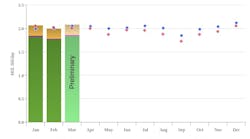Resilience entered the US national policy vocabulary in April 2015 when the first US Quadrennial Energy Review identified deficiencies in oil, gas, and electricity transportation, storage, and distribution systems that emerged in Hurricane Katrina’s wake nearly 10 years earlier. Not many could have anticipated that an even more violent storm would put the system to a fresh test in late August 2017.
Hurricane Harvey did, however. By the time the strongest storm to hit Texas since 1961 made landfall around 10 p.m. CDT on Aug. 25, Gulf of Mexico offshore production platforms had been evacuated and shut-in. By Aug. 27, 22% of the oil production and 27.5% of the gas production in the gulf was off-line, the US Department of Energy’s Infrastructure and Energy Restoration Office said on Aug. 28.
Most Gulf Coast refineries also had shut down, it continued. “Retail gas station outages have been reported in the impacted region; however, overall stocks of gasoline and distillate in the region are at or above the top end of the 5-year range,” IERO said. “DOE is working closely with the Energy Information Administration to further assess potential impacts at both a regional and national level.”
Valero Energy Corp. closed its refineries at Corpus Christi and Three Rivers Aug. 25, and reported 2 days later that neither was damaged substantially. “We are working closely with local, state, and federal agencies as well as our business partners to evaluate infrastructure needed to resume refinery [and], in particular, port operations,” it said.
“Our other Gulf Coast refineries continue to operate,” Valero continued. “We are closely monitoring the weather and flooding in the Houston area to evaluate any impact it may have on our operations.”
But one of Katrina’s most bitter lessons was that while major Gulf Coast pipelines themselves weren’t damaged, they also weren’t of much immediate use because electricity to run their pumps wasn’t available.
Longer restoration times
IERO’s Aug. 28 bulletin noted there were 291,181 customer power outages across Texas and none of any significance in Louisiana. “Impacted utilities have issued statements that they are expecting power outages to last several days,” it said. “Restoration efforts cannot begin until weather conditions are safe. High rainfall total and flooding could extend restoration times in many affected areas.
“Before equipment in flooded areas can be reenergized, waters will need to recede and equipment at substations will need to dry out and be inspected for damage. Additionally, before customers can have electricity restored to homes or business impacted by flooding, customers need to have electrical equipment inspected,” IERO said. Consequently, Harvey’s peculiarities may help identify response strengths and weaknesses developed since Katrina.
